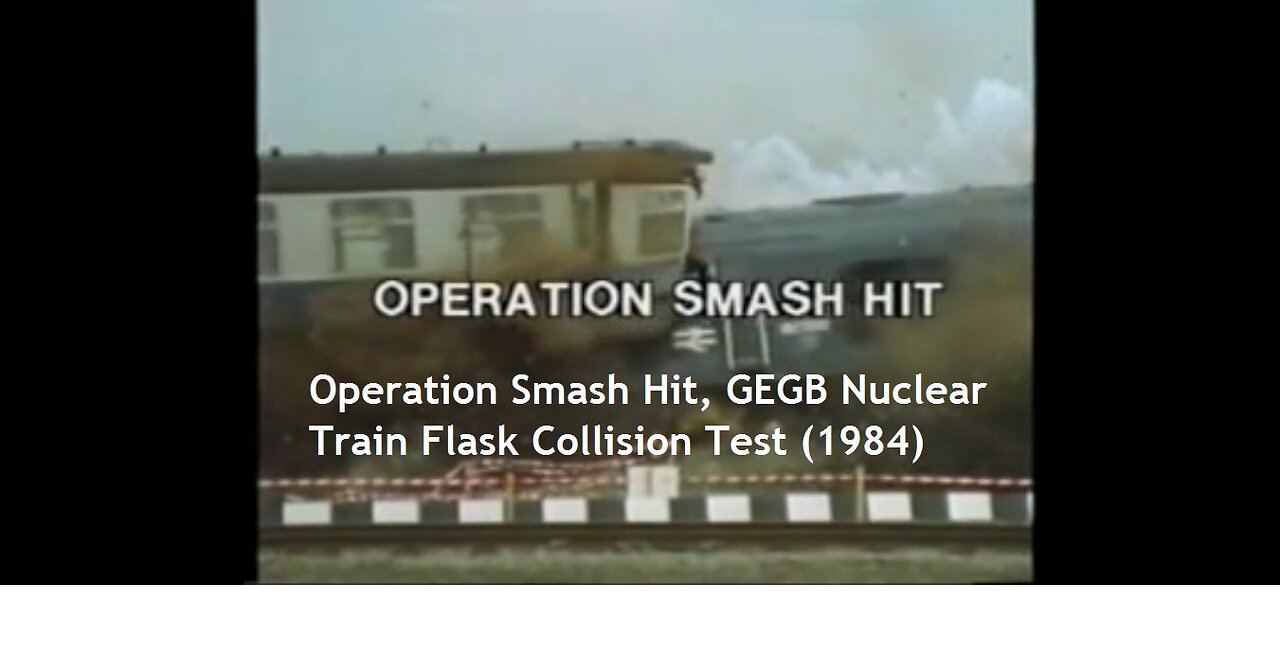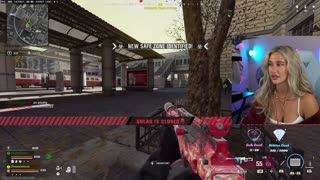Premium Only Content

CEGB Nuclear Train Flask Collision Test - Operation Smash Hit (1984)
YouTube Views before YouTube killed off my PublicEnquiry channel : 596,200
Category: Science & Technology
Published on Apr 23, 2011
Hereby follows the propaganda:
When nuclear fuel is sent from Britain's nuclear power stations to Sellafield for reprocessing, a simple procedure is used which now has been carried out more than 14,000 times.
The fuel rods are first cooled for at least 90 days at power station by immersing them in ponds. When taken out of storage the heat coming from each rod has dwindled to about 25 watts - roughly equivalent to a small electric light bulb.
About 200 rods at a time are loaded into an open top steel skip which is then placed inside a special container called a flask.
The flasks are very robust - they weigh around 50 tons and have walls 35 cm thick.
16 bolts, each able to take a load of 150 tons without breaking, secure the lid.
The flasks are forged out of two blocks of steel. When finished each flask is worth half a million pounds.
Stringent manufacturing and performance standards have to be met. These are drawn up by International Atomic Energy Agency.
To meet these standards the industry has developed a comprehensive testing program. Literally hundreds of impact tests have been carried out using scaled models dropping them so that they land from all sorts of different angles.
In 1983 to enhance public confidence in the flasks a full scale testing of an actual production flask in real life conditions was begun.
A three locomotive train was smashed into a flask going at 100mph.
Operation Smash Hit ’84 by Alex Bestwick
https://www.railwaymagazine.co.uk/25694/from-the-archive-operation-smash-hit-84/
British Railways and the Central Electricity Generating Board deliberately destroy a train to prove the safety of nuclear fuel flasks.
Close-up of the wrecked train from the rear: the nuclear fuel flask lies on its side to the right of the train, with the ”Flatrol” wagon body across the roof of the first coach. Pieces of locomotive and coach bogies and underframes litter the foreground
At lunchtime on Tuesday July 17, class “46” locomotive No. 46 009 and three Mkl coaches. Nos. E25154. M4514 and E25564. crashed at 100 m.p.h. into a derailed “Flatrol” wagon, loaded with a steel flask of of the type used for carrying irradiated fuel rods from nuclear power stations to the works of British Nuclear Fuels Limited in Cumbria. for reprocessing.
However, this was no accident. but part of a four—year £4m programme of tests on full—size nuclear fuel flasks undertaken by the Central Electricity Generating Board to allay any public disquiet on the ability of these vessels to stand up to the severest forms of accident. The flask in the test. which was loaded with three tonnes of steel bars to simulate nuclear fuel rods, and filled with water at 100 lb. per sq. in. (though about 15 lb. per sq. in. is the normal service pressure). survived the impact virtually unscathed, apart from a gouge on the lid, and only lost 0.2 lb. per sq. in. pressure as a result of the impact.
British Railways has been carrying these flasks safely round the country for some twenty years now, in which time there have been no serious incidents involving them, but persistent fears have been voiced by an anti-nuclear lobby, as a result of which the CEGB embarked on a series of tests with half and quarter-full—size models. However. its critics were not satisfied, saying that models were all very well, but what about the real thing? Would it behave in the same way as the models? This caused the CEGB to undertake full—size tests, which it had up to then resisted, because of the cost.
On March 6, 1984, a drop test of a full—size nuclear fuel flask was carried out at the CEGB Structural Test Centre at Cheddar, when a flask was dropped from a height of 29 1/2 ft. (9m) onto concrete and steel anvils and met the requirements of the International Atomic Energy Authority regulations by a large margin. As called for in these regulations, the same flask was used in the rail crash demonstration.
The crash was staged on the Edwalton to Melton Mowbray test track used experimentally by British Railways Research Department, near the site of Old Dalby Station. The cost to the CEGB was £1.6m. including the rolling stock and compensation to local landowners (part of this was £2,000 for disturbing the pheasants!). Two trains were chartered from BR by the CEGB, and run from St. Pancras to and from the test site, one carrying press and CEGB and BR officials, the other (which used the set of FOs run by the Steam Locomotive Operators Association while its Pullman cars are having asbestos removed at Carnforth) carrying other invited guests, including observers from most of the nuclear power stations in Britain. Two viewing stands had been arranged, with tiers of seats, one on each side of the track, and a commentary was given over loudspeakers.
https://www.railwaymagazine.co.uk/25694/from-the-archive-operation-smash-hit-84/
-
 LIVE
LIVE
Rallied
22 minutes agoWARZONE SOLO CHALLENGES ALL DAY
183 watching -
 LIVE
LIVE
Nerdrotic
2 hours ago $1.58 earnedTransient Lunar Phenomenon: Deeper into the Mysteries of the Moon | Forbidden Frontier #112
608 watching -
 2:58:44
2:58:44
Barry Cunningham
1 day agoBREAKING NEWS: PRESIDENT TRUMP ABSOLUTELY TROLLS THE MEDIA! BIG WEEK AHEAD!
57.4K79 -
 1:37:28
1:37:28
Sarah Westall
3 hours agoReal Intel: Power Struggles Fueled by Blackmail, Surveillance & Coercion w/ Dr. Dave Janda
18.2K9 -
 9:49
9:49
MattMorseTV
5 hours ago $9.89 earnedNewsom's CAREER just WENT UP IN FLAMES.
21.6K59 -
 LIVE
LIVE
Spartan
3 hours agoHalo for a bit, Octopath after maybe
131 watching -
 3:49:55
3:49:55
sophiesnazz
4 hours ago $2.04 earned6kd in these lobbies !socials !specs
23.7K1 -
 LIVE
LIVE
Vedic compatability astrology
2 hours agoAbijit Shuckla: The Epic 8, 17, 25 Adventure!
75 watching -
 1:17:18
1:17:18
Jeff Ahern
5 hours ago $13.30 earnedThe Sunday Show with Jeff Ahern
41.1K6 -
 4:17:59
4:17:59
The Rabble Wrangler
5 hours agoSunday Shootouts in Battlefield 6 - Phantom Edition Giveaway!
14.1K